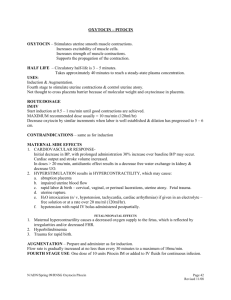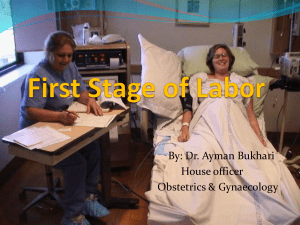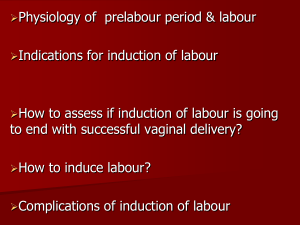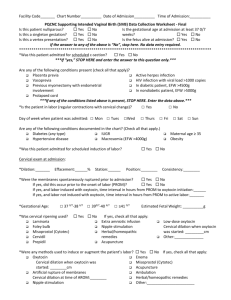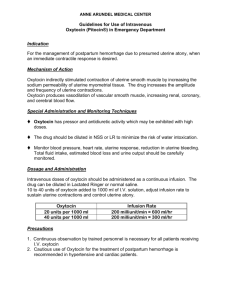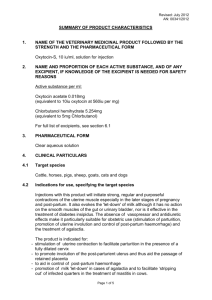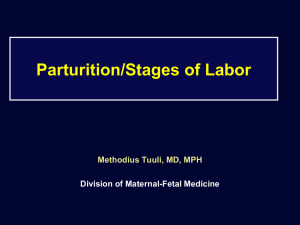Prolonged labor
advertisement
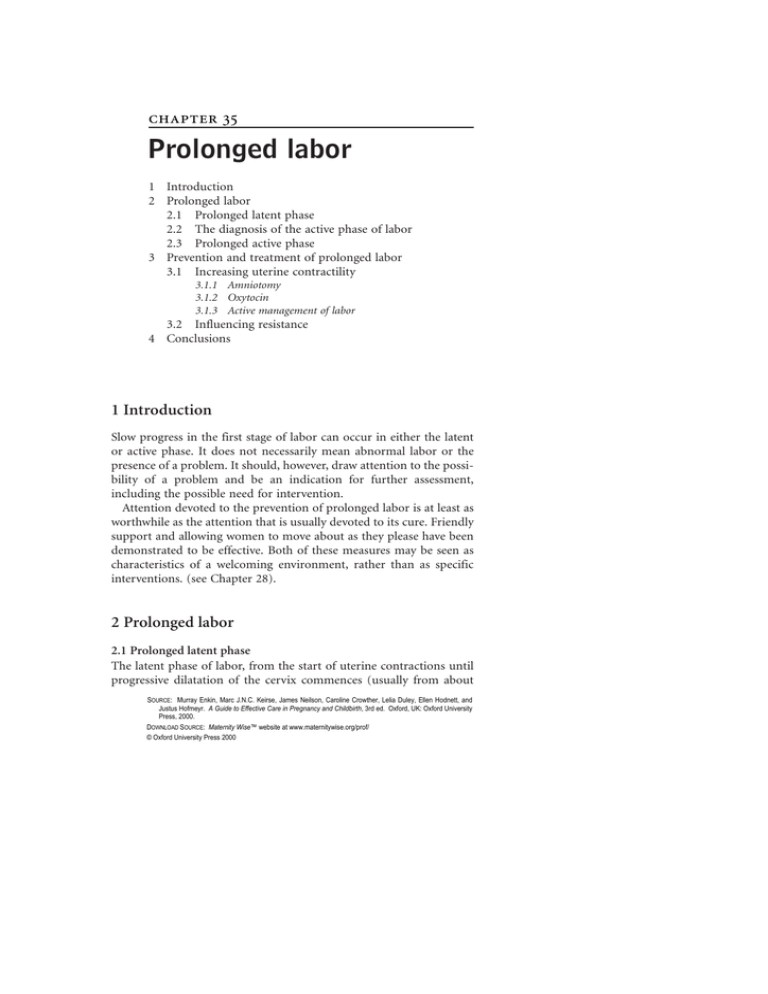
1 2 3 4 5 6 7 8 9 10 1 2 3 4 5 6 7 8 9 20 1 2 3 4 5 6 7 8 9 30 1 2 3 4 5 6 7 8 9 40 41 Prolonged labor 1 Introduction 2 Prolonged labor 2.1 Prolonged latent phase 2.2 The diagnosis of the active phase of labor 2.3 Prolonged active phase 3 Prevention and treatment of prolonged labor 3.1 Increasing uterine contractility 3.1.1 Amniotomy 3.1.2 Oxytocin 3.1.3 Active management of labor 3.2 Influencing resistance 4 Conclusions 1 Introduction Slow progress in the first stage of labor can occur in either the latent or active phase. It does not necessarily mean abnormal labor or the presence of a problem. It should, however, draw attention to the possibility of a problem and be an indication for further assessment, including the possible need for intervention. Attention devoted to the prevention of prolonged labor is at least as worthwhile as the attention that is usually devoted to its cure. Friendly support and allowing women to move about as they please have been demonstrated to be effective. Both of these measures may be seen as characteristics of a welcoming environment, rather than as specific interventions. (see Chapter 28). 2 Prolonged labor 2.1 Prolonged latent phase The latent phase of labor, from the start of uterine contractions until progressive dilatation of the cervix commences (usually from about SOURCE: Murray Enkin, Marc J.N.C. Keirse, James Neilson, Caroline Crowther, Lelia Duley, Ellen Hodnett, and Justus Hofmeyr. A Guide to Effective Care in Pregnancy and Childbirth, 3rd ed. Oxford, UK: Oxford University Press, 2000. DOWNLOAD SOURCE: Maternity Wise™ website at www.maternitywise.org/prof/ © Oxford University Press 2000 1 2 3 4 5 6 7 8 9 10 1 2 3 4 5 6 7 8 9 20 1 2 3 4 5 6 7 8 9 30 1 2 3 4 5 6 7 8 9 40 41 4-cm dilatation onwards), is poorly understood. As this phase usually starts before the woman is admitted to hospital, its precise time of onset is often difficult to determine. The duration of the latent phase varies so widely from woman to woman that a normal range is difficult to define. According to some studies, a prolonged latent phase is not associated with increased perinatal morbidity, mortality, or other adverse outcome. Other studies have shown a significantly higher incidence of cesarean section and lower 5-min Apgar scores, in both primigravidae and multigravidae, with a prolonged latent phase. Whether these adverse effects were due to the underlying condition or the result of injudicious treatment is uncertain. Differentiating between a prolonged latent phase and false labor is often difficult. This distinction can only be made in retrospect. There is an urgent need for controlled studies about this common, distressing, and poorly understood problem in labor, its etiology, its significance, and the best policy of care. 2.2 The diagnosis of the active phase of labor When active labor is mistakenly diagnosed, failure of the cervix to dilate within a prescribed period of time results in the erroneous diagnosis of dystocia. Mothers may feel inadequate because of not achieving the expected progress, and may lose confidence in their caregivers when a diagnosis of active labor is made in error. Interventions to stimulate labor and cesarean sections for dystocia are sometimes performed before the establishment of true labor (see Chapter 31). 2.3 Prolonged active phase Slow progress or failure to progress in the active phase of labor can be defined either as an overall measurement (e.g. longer than ‘x’ hours), or as a rate-related measurement (e.g. a rate of cervical dilatation of less than ‘y’ cm/hour). The commonly cited 12-hour duration of the active phase is roughly equivalent to a rate of 0.5 cm/hour, half as fast as the 1 cm/hour that is also commonly used. The diagnosis of slow progress depends on careful documentation of the labor progress, preferably by plotting changes in cervical dilatation and descent of the head on a labor graph. Deviation from this arbitrarily defined ‘normal’ rate of dilatation should be an indication for evaluation rather than for intervention. While there is certainly an association between prolonged labor and adverse outcome, the extent to which the relationship is causal is by no means certain. 1 2 3 4 5 6 7 8 9 10 1 2 3 4 5 6 7 8 9 20 1 2 3 4 5 6 7 8 9 30 1 2 3 4 5 6 7 8 9 40 41 Cephalopelvic disproportion must be considered when progress in labor is slow. Intrapartum x-ray pelvimetry has not proven to be useful for women with the fetus in a cephalic presentation. The available controlled trials show a significant increase in cesarean section or symphisiotomy rates with the use of intrapartum x-ray pelvimetry, but no significant benefits in terms of reduced neonatal morbidity. The diagnosis of cephalopelvic disproportion is made by excluding functional causes (uterine hypotonia) for slow progress in labor. Uterine contractions of adequate intensity must be assured, by stimulation if necessary, before this diagnosis can be made. If gross cephalopelvic disproportion, possibly suggested by marked moulding of the fetal skull, is present, a cesarean section is necessary. Epidural analgesia may be associated with an increase in the length of the first and second stage of labor, the need for oxytocin, the incidence of fetal malposition, the use of instrumental delivery if the block is maintained beyond the first stage of labor, and the need for cesarean section for failure to progress. 3 Prevention and treatment of prolonged labor Protracted labor has been recognized as a problem for centuries, and a bewildering variety of treatments has been proposed to correct the condition. The assumption underlying all these treatments is that, in some way, ‘inadequate’ progress is bad and that ‘something should be done about it’. In the past, proposed remedies have included homeopathic medications, various spasmolytic drugs, sparteine sulphate, estrogens, relaxin, caulophyllum, dimenhydrate, nipple stimulation, intracervical injections of hyaluronidase, vibration of the cervix, and acupuncture. The most commonly used measures today are amniotomy (artificial rupture of the membranes) and intravenous oxytocin infusion. Many factors can influence uterine contractions and the progress of labor. Consideration of these factors suggests a number of measures that can help to prevent prolonged labor and obviate much of the need for augmentation. The presence of a supportive companion and ambulation during labor have been shown to result in shorter labors and a lesser use of oxytocics. When more active intervention is required, this may consist of measures to increase the power of the uterine contractions, or to reduce the degree of resistance to cervical dilatation and descent of the presenting part. 1 2 3 4 5 6 7 8 9 10 1 2 3 4 5 6 7 8 9 20 1 2 3 4 5 6 7 8 9 30 1 2 3 4 5 6 7 8 9 40 41 3.1 Increasing uterine contractility There is a close relationship between low levels of uterine contractility and slow progress in labor. Treatments to increase uterine contractility may be based either on increasing the endogenous production of prostaglandins by amniotomy or the administration of uterine stimulants, such as exogenous oxytocin or prostaglandins. 3.1.1. Amniotomy A policy of early amniotomy leads to a reduction, on average, of between 60 and 120 minutes in the duration of labor, and also to a reduction in the incidence of dystocia (defined as a mean rate of dilatation less than 0.5 cm/hour). In one trial, the reduction in labor duration was limited to primiparous women. Oxytocin augmentation is used less frequently after early amniotomy. No effects of early amniotomy have been noted on the use of analgesia or rates of instrumental vaginal delivery. Early amniotomy was associated with a trend to increased use of cesarean section, possibly related to increased diagnosis of fetal distress. In a recent trial, early amniotomy was associated with an increased rate of fetal heart-rate abnormalities. The effects of early amniotomy on the baby are also open to interpretation. Meta-analysis of the controlled trials shows that early amniotomy is associated with fewer low 5-minute Apgar scores but has no effect on the incidence of low arterial cord pH. There is a nonsignificant trend toward an increase in the frequency of cephalhematoma and meconium aspiration. A variety of adverse effects have been postulated but they have not been confirmed by controlled studies. The studies that purported to show these harmful effects of amniotomy on the fetus and neonate were all subject to considerable selection bias, precluding an adequate assessment of the effects of amniotomy. In HIV-infected women, observational studies indicate that ruptured membranes for more than 4 hours before delivery increases the risk of neonatal infection. On this basis, amniotomy may be dangerous for the babies of these women. In the studies that assessed mothers’ views of the policy of membrane management, there was no evidence that the differences in policy affected the mothers’ opinions. However, a policy of early amniotomy is associated with a statistically significant reduction in the risk of experiencing ‘horrible or excruciating’ pain at some time in labor. None of the reported studies specifically addressed the question of whether or not amniotomy is effective in augmenting slow or 1 2 3 4 5 6 7 8 9 10 1 2 3 4 5 6 7 8 9 20 1 2 3 4 5 6 7 8 9 30 1 2 3 4 5 6 7 8 9 40 41 prolonged labor. Given the evidence that is available from the controlled trials in spontaneous labor, and from the data on induction of labor, it is highly likely that amniotomy would enhance progress in prolonged labor as well. 3.1.2 Oxytocin Intravenous infusion of synthetic oxytocin, usually after either spontaneous or artificial rupture of the membranes, is the most widely used treatment to expedite labor when progress is deemed to be inadequate. Despite this, there is remarkably little evidence about the effects of oxytocin from controlled trials. The effect of oxytocin stimulation on duration of labor is still not clear. Of three earlier trials that provide data on the length of labor when intravenous oxytocin infusion was used in cases of poor progress, only one showed a shorter mean duration in women allocated to early oxytocin augmentation compared with controls. In one trial in which women in the control group were encouraged to get up and to move around, stand, or sit as they wished, the mean duration of labor was slightly shorter in the control group than in the augmented group. A recent small trial showed improved labor progress with oxytocin. There is no evidence from these trials that a policy of early oxytocin use influences the method of delivery. Neither Apgar scores nor the incidence of admission to a special care nursery were detectably different between oxytocin augmentation and control groups in the trials that reported on these outcomes. No other categorical data on infant outcomes are available from controlled trials. In one study, over half of the women asked about their opinion on the oxytocin treatment said that it was unpleasant and indicated that they would like to try without the drug when next giving birth. Over 80% felt that it had increased the amount of pain that they had experienced, whereas less than 20% of the women in the ambulant group felt that walking about had increased their pain. Conversely, in a recent trial women expressed a preference for active management when poor progress of labor was diagnosed. From the data available thus far, it is not clear that liberal use of oxytocin augmentation in labor is of benefit to the women and babies so treated. This does not imply that there is no place for oxytocin augmentation in slow progress of labor. In the earlier controlled trials, a high proportion of the women assigned to be controls ultimately received oxytocin for subsequent failure to show adequate progress in 1 2 3 4 5 6 7 8 9 10 1 2 3 4 5 6 7 8 9 20 1 2 3 4 5 6 7 8 9 30 1 2 3 4 5 6 7 8 9 40 41 labor (as defined by the authors). These studies thus indicate that many women who are not treated early with oxytocin for inadequate progress, will still receive an oxytocin infusion before delivery. It does suggest, however, that other simple measures, such as allowing the woman freedom to move around and to eat and drink as she pleases, may be at least as effective and certainly more pleasant for a sizeable proportion of women considered to be in need of augmentation of labor. Situations will undoubtedly remain in which pharmacological augmentation will be necessary to correct inadequate uterine activity, in order to prevent maternal exhaustion, and risks of fetal and maternal infection. Logic would dictate that, in such circumstances, the smallest effective drug dose be given, in the most effective manner. As individual sensitivity to oxytocin varies greatly from woman to woman, oxytocin titration by means of an intravenous infusion is the treatment of choice. It is less clear, however, what the initial dose should be, how large the increments should be, and at what interval they should be implemented. Little data are available to answer these questions. Two principles should guide the clinician when using oxytocin to augment labor: first, to avoid hyperstimulation; second, that the therapeutic trial should be sufficient to minimize the risk of a false diagnosis of cephalopelvic disproportion. Insufficient doses will take an unacceptably long time to achieve an adequate response, while excessive doses will result in hyperstimulation. Slow progress in cervical dilatation is not necessarily due to subnormal levels of uterine activity. The level of activity that is needed both to ensure adequate progress and to avoid hyperstimulation has not yet been established. A major additional factor in the rate of progress of labor is the amount of resistance that must be overcome. 3.1.3 Active management of labor The term ‘active management of labor’ was introduced to describe a comprehensive program of care in labor, the key elements of which include, in addition to strict diagnostic criteria for labor, early amniotomy, early use of oxytocin, and continuous professional support. Uncontrolled studies have suggested that liberal use of both amniotomy and oxytocin augmentation may be instrumental in achieving low cesarean-section rates. This may well prove to be the case but it has not been demonstrated by the results of the published controlled trials. Two published trials showed a small and statistically insignificant reduction in the cesarean-section rate; the others showed 1 2 3 4 5 6 7 8 9 10 1 2 3 4 5 6 7 8 9 20 1 2 3 4 5 6 7 8 9 30 1 2 3 4 5 6 7 8 9 40 41 no effect. The results for other outcomes (use of epidural, neonatal morbidity) also showed no effects of the policy. Unfortunately, the total number of women included in these trials is too small to give a clear indication of the effect of active management of labor on the rates of cesarean section or operative vaginal delivery. Analysis of studies of the various components of ‘active management of labor’ has found evidence of improved outcome for labor support but not for the other two main components of active management: early amniotomy and oxytocin use. 3.2 Influencing resistance Between a third and a half of the women with slow progress in labor have levels of uterine activity usually judged to be adequate. One care alternative for these women would be the use of high doses of oxytocin, to augment uterine activity to levels well in excess of those encountered during normal spontaneous labor. A more logical approach would be to reduce cervical resistance. Three methods to influence resistance in order to accelerate cervical dilatation have been tested in controlled trials: the use of intravenous or intramuscular porcine relaxin; local cervical injections of hyalouronidase; and cervical vibration. The trials did not demonstrate any advantage from the use of these modalities. Observational studies, however, have suggested that vibration may be useful when cervical dilatation is not achieved despite satisfactory uterine activity in the absence of cephalopelvic disproportion, and that the procedure appears to be safe. Evaluation awaits a controlled trial of adequate size. Despite the fact that their use would seem reasonable, measures to reduce soft tissue resistance have not been adequately explored. 4 Conclusions Slow progress or lack of progress in the first stage of labor usually, but not necessarily, results from a lower level of uterine contractility than that seen in normally progressing labors. It may be due to a higher resistance in the soft parts of the birth canal or to cephalopelvic disproportion. It will often be necessary to ensure that adequate uterine contractility exists, if necessary by oxytocic stimulation, in order to differentiate these dissimilar mechanisms. Every effort should be made to correct uterine hypotonia before resorting to cesarean section for dystocia. 1 2 3 4 5 6 7 8 9 10 1 2 3 4 5 6 7 8 9 20 1 2 3 4 5 6 7 8 9 30 1 2 3 4 5 6 7 8 9 40 41 It is too early to recommend active management of labor on the basis of currently available evidence. Approximately half of the women judged to have slow labor or poor progress in cervical dilatation will progress equally well whether or not oxytocic drugs are administered. When augmentation becomes necessary, the first approach should be to rupture the membranes. The data that are available suggest that amniotomy will shorten the length of spontaneous labor and that it may forestall the need for oxytocin infusion in some of these women. Moreover, the combination of amniotomy with oxytocin may provide a better stimulation of labor than oxytocin alone. A possible exception is HIV-infected women, because of the possible increased risk of neonatal infection. There is no evidence that high and rapidly escalating doses of oxytocin confer any advantage over a more moderate approach in which small doses are increased at half-hourly intervals in response to uterine contractility. The risks of hyperstimulation and increased pain are greater with larger doses of oxytocin. Other methods for augmenting uterine activity, including the use of prostaglandins, are certainly worth considering, but they have been inadequately explored up to the present time. In view of the importance of labor progress and the amount of discomfort that slow progress can provoke in the woman, the fetus, and the caregivers, it is important that the many suggested guidelines for care be substantiated by solid research evidence. Sources Effective care in pregnancy and childbirth Crowther, C., Keirse, M.J.N.C. and Brown, I., Monitoring the progress of labour. Keirse, M.J.NC., Augmentation of labour. Cochrane Library Fraser, W.D., Krauss, I., Brisson-Carrol, G., Thornton, J. and Breart, G., Amniotomy for shortening spontaneous labour. Hodnett, E.D., Caregiver support for women during childbirth. Howell, C.J., Epidural versus non-epidural analgesia for pain relief in labour. 1 2 3 4 5 6 7 8 9 10 1 2 3 4 5 6 7 8 9 20 1 2 3 4 5 6 7 8 9 30 1 2 3 4 5 6 7 8 9 40 41 Lauzon, L., Hodnett, E., Caregivers’ use of strict criteria for diagnosing active labour in term pregnancy. Antenatal education for self-diagnosis of the onset of active labour at term. Pattinson, R.C., Pelvimetry for fetal cephalic presentations at term. Pre-Cochrane reviews Fraser, W.D., Early oxytocin to shorten spontaneous labour. Review no. 04136. Relaxin to shorten spontaneous labour. Review no. 04132. Cervical vibration to shorten spontaneous labour. Review no. 04133. Other sources Blanch, G., Lavender, T., Walkinshaw, S. and Alfirevic, Z. (1998). Dysfunctional labour: a randomised trial. Br. J. Obstet. Gynaecol., 105, 117–20. Johnson, N., Lilford, R., Guthrie, K., Thornton, J., Barker, M. and Kelly, M. (1997). Randomised trial comparing a policy of early with selective amniotomy in uncomplicated labour at term. Br. J. Obstet. Gynaecol., 104, 340–6. Rogers, R., Gilson, G.J., Miller, A.C., Izquierdo, L.E., Curet, L.B. and Qualls, C.R. (1997). Active management of labor: does it make a difference? Am. J. Obstet. Gynecol., 177, 599–605. Thornton, J.G. and Lilford, R.J. (1994). Active management of labour: current knowledge and research issues. BMJ, 309, 366–9. Zhang,J., Bernasko, J.W., Leybovich, E., Fahs, M. and Hatch, M.C. (1996). Continuous labor support from labor attendants for primiparous women: a meta-analysis. Obstet. Gynecol., 88, 739–44.
